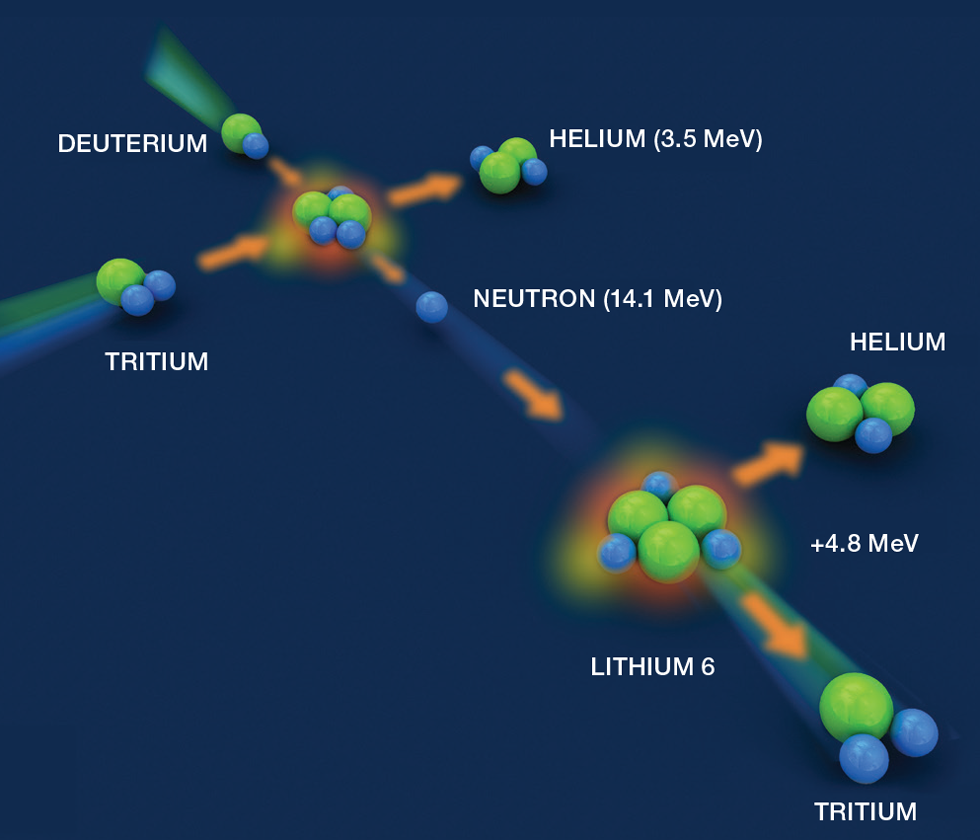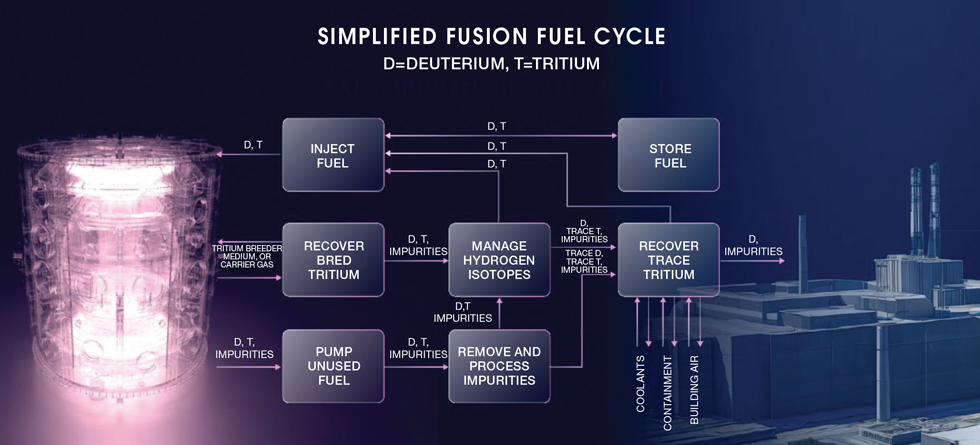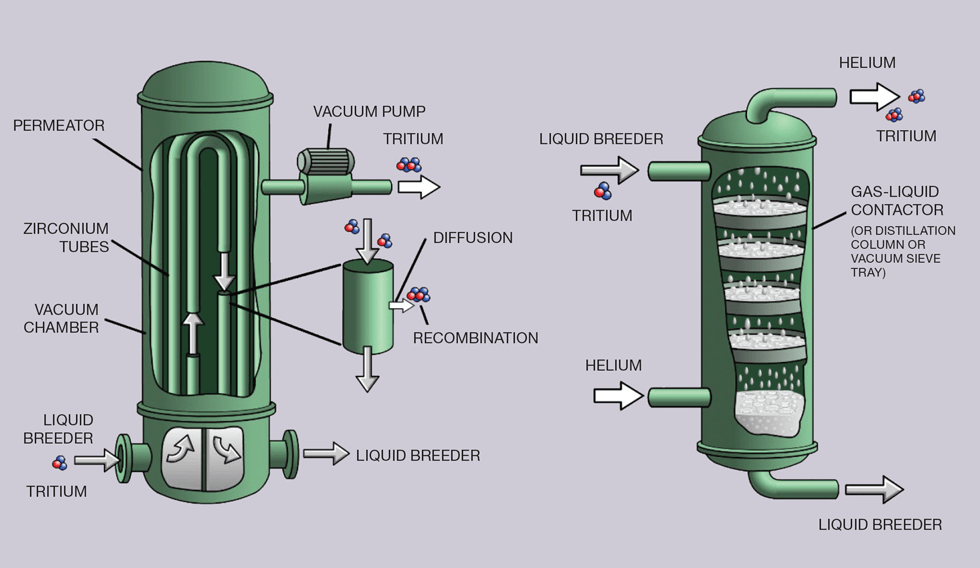The Challenges of Developing a Fusion Fuel Cycle: and How Chemical Engineers are Solving Them
Elaine Loving and Tom Stroud outline the scientific and technical challenges that must be met for the potential of fusion energy to be realised
FUSION energy has the potential to be a safe, sustainable, and low carbon part of the world’s future energy supply. Sometimes described as the ultimate energy source, it is based on the same processes that power the stars.
However, fusion energy is also one of the great scientific and engineering challenges of our time.
Recent fusion developments
Fusion has been in the spotlight in recent years thanks to significant milestones in the development of fusion energy both in the UK and globally.
In 2022, the United Kingdom Atomic Energy Authority (UKAEA) announced they had achieved a record-breaking 59 MJ of sustained fusion energy at high power using a tokamak.1 In the US, scientists successfully demonstrated net energy gain from fusion using lasers2 – and repeated the demonstration in recent months.
This year, the UK government alongside UKAEA established a delivery body, UK Industrial Fusion Solutions (UKIFS), for the Spherical Tokamak for Energy Production (STEP) programme. STEP is the UK’s prototype fusion powerplant to be built at West Burton in Nottinghamshire and has the ambitious goal of being electrically net positive in the 2040s.

What is fusion energy?
When lighter nuclei fuse to form a heavier nucleus, they release energy. This is the opposite of nuclear fission – the reaction currently used in nuclear power stations – in which energy is released when a nucleus splits apart to form smaller nuclei.
There are multiple potential approaches to creating fusion energy.
UKAEA’s approach to fusion energy involves using strong magnets to hold a plasma in a ring-shaped machine called a tokamak. This magnetic confinement method is used in UKAEA’s Joint European Torus (JET) and the Mega Amp Spherical Tokamak Upgrade (MAST-U) device – both in Culham, Oxfordshire, UK – and will be used in STEP.
Other approaches to fusion include:
- inertial confinement, which involves rapidly compressing a small capsule containing fusion fuel, (often, though not always using high-energy lasers) to create a plasma and, thus fusion conditions
- magnetised target fusion, where magnetic confinement and inertial confinement are combined to create fusion conditions
- field-reversed configuration devices which attempt to create a magnetically contained plasma volume with no central tube or solenoid
- stellarators that employ complex coil configurations to apply magnetic containment to a twisted hoop-shaped plasma volume
Fusion fuel cycle in brief
Hydrogen normally refers to protium (H), the lightest form of hydrogen containing only a single proton. For fusion power production, the more common fusion fuel of choice is a mixture of the heavier hydrogen isotopes, deuterium (D) and tritium (T). Only a small fraction of the fuel injected is fused due to challenges with plasma confinement and contamination. A fusion fuel cycle is the pathway of removing, processing, and reinjecting fuel to the plasma in a continuous manner, while safely containing these fuels.

Deuterium and tritium hydrogen isotopes
Deuterium is naturally abundant in seawater and is non-radiological, whereas tritium is a weak beta emitter with a half-life of 12.3 years. Because tritium is not available naturally, fusion energy powerplants must produce it (“breed”) using a “breeder blanket”, which generally contains lithium.
Aside from fusion, other uses of tritium include glow-in-the-dark lighting, as biomedical tracers, or for academic research. Due to its limited applications, tritium handling and processing is relatively novel when compared with other industrial processes.
Alongside general hydrogen handling considerations (such as flammability, reactivity, and containment) tritium presents some unique challenges.
Hydrogen isotopes have the ability to exchange with each other, resulting in multiple isotopic forms of the same compound; known collectively as isotopologues. For example, H2 can exist as HH, HD, HT, DD, DT, and TT. Tritium typically has a higher tendency to exchange, resulting in a greater likelihood of tritiated compounds forming.
These isotopologues often have similar, but not identical, physical properties and reaction kinetics. The magnitude of differences in behaviour may prove both opportunistic and detrimental.
The permeability of hydrogen through various materials is a known phenomenon, but tritium transport and retention is not well understood. Swings in pressure and temperature can be beneficial for recovering trapped hydrogen. However, with little experimental data available for validation, this remains challenging to quantify and model.
Chemical engineers solving fusion challenges: Elaine Loving

After graduating with a chemical engineering degree from Loughborough University, Elaine joined UKAEA in her current role in 2021 following a career in oil and gas and precious metal recycling. Elaine worked within UKAEA as part of the business development team before becoming the fuel recirculation separation systems lead within the fuel cycle team on STEP. Elaine works on behalf of the H3AT division, who are pioneering research into tritium breeding, processing, distribution, storage, recycling, and disposal. Elaine has recently concluded technology optioneering studies for the hydrogen isotope separation and impurities management for the STEP fuel cycle. With preferred technologies identified, Elaine’s day comprises of establishing technology development roadmaps, design development, optimisation, and establishing mechanisms to address technology challenges.
How do these challenges impact the design?
A fusion fuel cycle must achieve the following:
- Integrated design philosophy: The fuel cycle is impacted by a range of design and operational choices in the fusion plant, both internal and external to the system. Ensuring decisions are made in an integrated way, understanding the impact across all plant systems, is critical for delivering a viable design. For example, some gases may be preferable for plasma control but cause issues for the fuel cycle, either from difficulty in separation, direct reaction with tritium, or production of radioactive by-products (eg nitrogen and tritium can form tritiated ammonia which negatively impacts many processes)
- Robust design: For a commercial fusion power plant to be realised, the whole plant must operate continuously. However, the plant must be able to cope with all operational phases including, but not limited to, commissioning, emergency shutdown and maintenance. For the fuel cycle in particular, each phase represents a substantial change in flowrate, composition, and conditions which must be managed
- Tritium self-sufficiency: Given that tritium does not occur naturally, it will need to be generated by some means. A leading method is to breed tritium in-situ for prompt extraction and processing by the fuel cycle, to overcome losses through decay, permeation, and retention. For commercialisation to be realised, first-of-a-kind tokamaks must be net exporters of tritium to support the start-up of future plants
- Low tritium inventory: A low tritium inventory on the site of a fusion powerplant reduces the amount of tritium required for system start-up, minimises potential losses, and improves site safety. Inventory minimisation is a key performance measure for evaluating appropriate fuel cycle technologies and designs
- Tritium recovery and containment: Waste material from fusion powerplants is expected to be classified as no more than “intermediate level” and will be minimised by design. Part of this will involve almost complete recovery of tritium. This becomes challenging when considering losses through material permeation and retention. This may be achieved by using coaxial piping to capture permeated tritium, implementing permeation barrier coatings to pipework, and the use of detritiation (removal of tritium) processes in ventilation systems. This calls for different approaches across different streams, as some (such as fuelling systems) are high in tritium content, compared to parts-per-billion levels in others (such as ventilation)
- Isotope management: Protium will be present in the fuel cycle, whether outgassing from materials, as a byproduct of breeding, or as part of powerplant operation. The fuel cycle must remove protium while recovering tritium, requiring processes that can separate specific isotopes. Many of these techniques are challenging and require a high number of separation stages, such as cryogenic-distillation
- Impurity and accumulation management: Due to the cyclic nature of the fuel cycle, impurities must be removed to avoid accumulation and, if tritiated, recover the tritium. Sources may be solid, liquid, or gaseous and can arrive in a number of ways, including through system leakages, material outgassing, and injection of species into the tokamak for plasma control
- Industrially mature technologies: As fusion moves from research to commercialisation, processes must have a high technology maturity level to ensure reliability. The largest fusion fuel cycle to date is operated to support JET at UKAEA’s Culham site in Oxfordshire, UK. The requirements for the JET fuel cycle differ from those of a future fusion powerplant. Powerplant requirements will include higher throughput, processing a greater range of impurities, recovering tritium from breeder materials, coolants, and importantly, continuous operation. Technology maturity will require the development of testing programmes and engagement with wider industry
- Suitable materials: Materials must be able to withstand the properties associated with hydrogen and specifically tritium. Hydrogen embrittlement is a consideration during material selection, and tritium poses an additional challenge of material degradation from beta decay. In some plastics, tritium will isotopically swap with the hydrogen present and decay within the structure causing changes in the material properties. Many commercial off-the-shelf components such as pumps, valves, and instruments are therefore not tritium compatible
- Tritium accountancy: To enable continuous plant operation, tritium must be measured in real time. Existing techniques are slow batch processes that are typically operator intensive. New techniques will be developed to ensure tritium accountancy can be performed with the accuracy and speed necessary for a commercial power plant
Chemical engineers solving fusion challenges: Tom Stroud

Tom graduated from the University of Surrey as a chemical and process engineer, entering the oil refining sector where he oversaw the design, commissioning, and start-up activities for multiple refining units. He moved to UKAEA in 2021 to work within the fuel cycle and power Infrastructure teams on the STEP project, undertaking technology assessments and basic sizing calculations for many promising separation technologies and power cycle options. Currently a team lead within the fuel cycle, overseeing the tritium recovery aspects such as tritium extraction system, and coolant detritiation and purification.
Case study: tritium extraction
The tritium extraction system (TES) provides a prime example of how chemical engineering principles can be applied to address various fusion challenges. The purpose of the TES is to extract tritium from the breeder blankets which surround the plasma and is essential for fuel self-sufficiency.
Many different blanket concepts exist, but they all have one common requirement: the inclusion of lithium. Under neutron bombardment, lithium splits to form tritium and helium-4. Leading designs typically include solid “pebbles”, pure liquid lithium, a lithium-lead eutectic mixture, or as a molten salt. Each type has its advantages and challenges, and chemical engineering principles are crucial in determining the most effective design and implementation strategy for each concept.
All structures within the tokamak become heated and, therefore, require active cooling. The blanket structure itself represents the largest energy source from tokamaks and plays a crucial role in power generation. This can present major design trade-offs between tritium self-sufficiency and power generation, as some designs favour a higher breeding potential but may have a negative impact on power generation.
These considerations extend not only to the breeder blanket, but also to tritium extraction technologies. For example, some designs suggest the use of a continuous helium purge to aid in tritium recovery, which incurs a large compression duty. Coolants, and even the final environmental heat exchange (eg a cooling tower) present a possible route for tritium to permeate out of the blanket and become unrecoverable. To address these issues, design strategies may include implementing barrier coatings and performing active detritiation on the coolant streams themselves.
Options such as liquid lithium can inherently reduce the potential of tritium permeation, as the solubility of hydrogen is extremely high. However, this makes extraction more challenging as the tritium will naturally stay within the lithium, ruling out otherwise promising processes, such as vacuum sieve trays, or permeation windows.
Tritium extracted from the breeder material will also contain deuterium and protium. These isotopes must be separated to meet the desired fuel specification before introduction to the fuelling systems. This can be done by either using a dedicated separation system or relying on those present within the wider fuel cycle. Trade-offs therefore exist between power consumption, complexity of design, processing time, and cross-contamination.
High level calculations and modelling will be used to estimate key performance indicators for tritium extraction systems, such as size, complexity, and extraction efficiency. Qualitative assessments such as evaluating technology maturity and assessing the impact on other parts of the fusion powerplant will contribute to the selection of the most suitable technology for further development.

Tools to overcome design challenges
There are many challenges to designing a fusion fuel cycle, but at the heart, it is a series of physical and chemical processes. Modelling is an essential tool for simulating interactions across all areas of the fusion power plant, with system requirement documents ensuring the design is fully integrated and consistent across interfaces. Technology optioneering assessments are also critical to ensure the selected processes are fit for purpose during these early stages of design.
Supporting this, sensitivity studies and statistical approaches are proving critical to understand the impact of unknown design conditions. These are helping to prioritise experimental testing programmes to rectify knowledge gaps and make quick decisions regarding technology feasibility for a range of design scenarios.
Unit operation design forms the crux of evaluating key performance indicators, such as tritium inventory, equipment size, and duty requirements. To aid in the design of the fuel cycle, process simulation software is used, but many initial evaluations are conducted from first principles and hand calculations – the fundamentals of heat and mass transfer, reaction engineering, thermodynamics, and fluid dynamics.
Safety and environmental studies (eg HAZOP studies, safety integrity levels, and best available technique (BAT) assessments) are being used to ensure designs consider these factors appropriately.
Operation of fusion fuel cycle relevant technologies are limited, so lessons must be learnt from existing industries (eg nuclear fission) and fusion machines, such as JET. Care must be taken to ensure that the differences and limitations are acknowledged and understood, but much can also be learnt from less obvious industries, such as air separation, gas processing facilities, or oil refineries.
Although many aspects of fusion – and by extension the fuel cycle – are novel, many principles, solutions, and general engineering rules of thumb that have been accumulated over decades of experience within these fields are being embraced.
The realisation of a fusion fuel cycle requires an integrated approach, with scientists and engineers across academia and industry working together to deliver a solution. This represents an exciting opportunity for chemical engineers to provide innovative and novel approaches to many of the challenges facing the realisation of fusion as a source of power.
Chemical engineers solving fusion challenges: Owen Franklin

Owen graduated from the University of Manchester as a chemical engineer and joined UKAEA in 2019. During his first few years he commissioned and operated the fuelling plant for the JET fusion reactor and is now responsible for the design and build of a cryogenic distillation sequence separating hydrogen isotopes. This will form part of a new fuel cycle research facility being developed by UKAEA. This facility will demonstrate novel unit operations and integrated control systems for modern fusion fuel cycles, while hosting gloveboxes for tritium related science.
References
1. https://www.tomorrowsworldtoday.com/2022/02/21/british-scientists-and-engineers-set-nuclear-fusion-record/
2. https://www.thechemicalengineer.com/news/us-announces-major-fusion-breakthrough/
3. IT Chapman & AW Morris, UKAEA capabilities to address the challenges on the path to delivering fusion power, Philosophical Transactions of the Royal Society A, 2019, https://doi.org/10.1098/rsta.2017.0436.
4. D Clery, Out of Gas, Science vol 376, pp1372–1376, 2022.
5. Z Franić, Radiotoxicity of tritiated water and tritiated hydrogen, Archives of Industrial Hygiene and Toxicology, 47(4), pp359–367, 1996.
6. M Kovari et al. Tritium Resources Available For Fusion Reactors. Nuclear Fusion, vol 58, 2, 2017, https://iopscience.iop.org/article/10.1088/1741-4326/aa9d25
7. https://www.telegraph.co.uk/business/2016/05/18/the-most-valuable-substances-in-the-world-by-weight/
Recent Editions
Catch up on the latest news, views and jobs from The Chemical Engineer. Below are the four latest issues. View a wider selection of the archive from within the Magazine section of this site.




